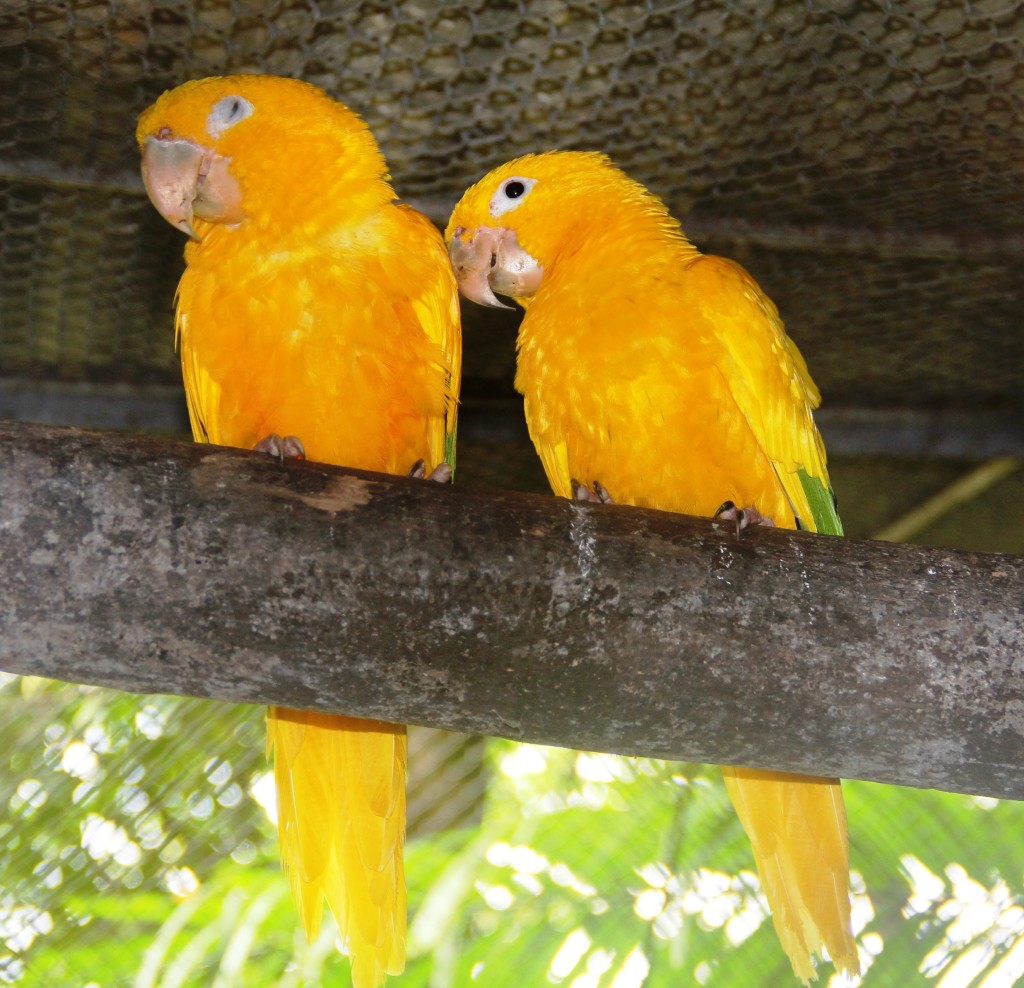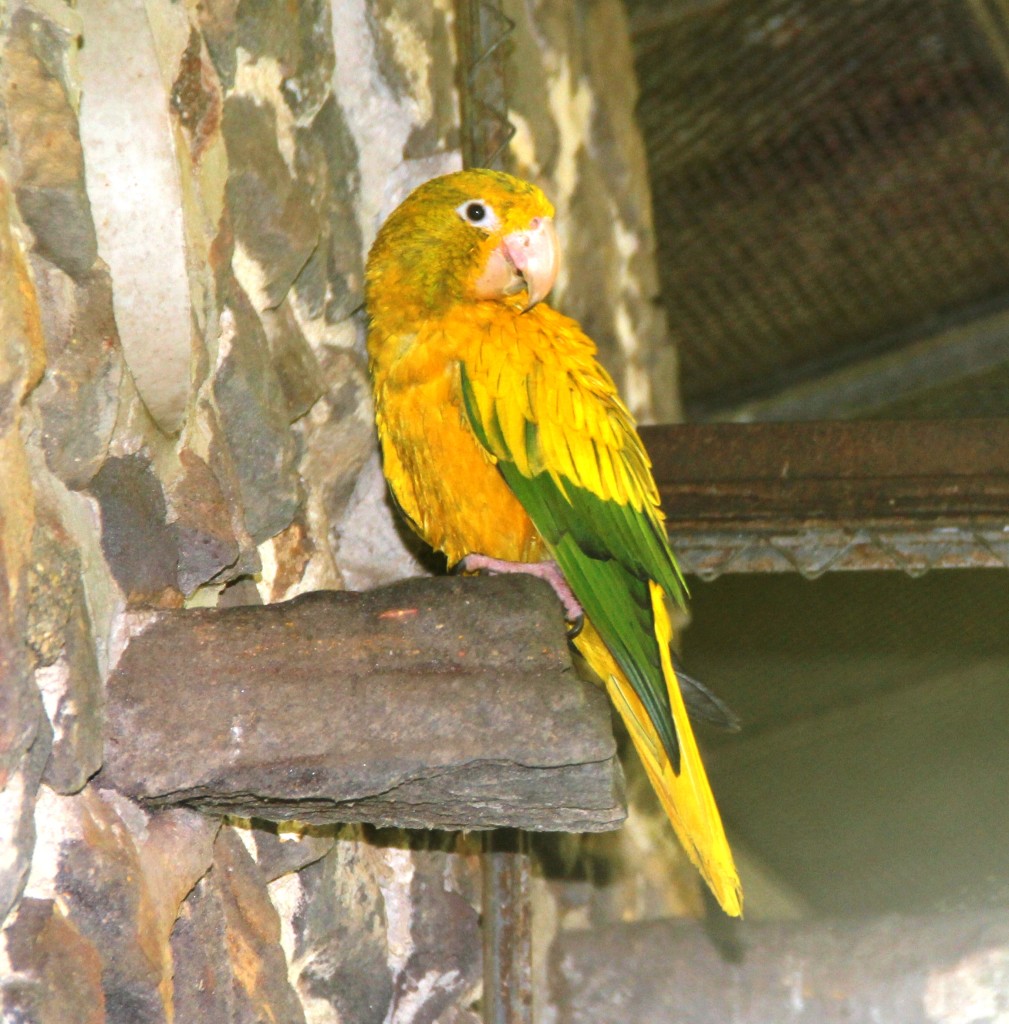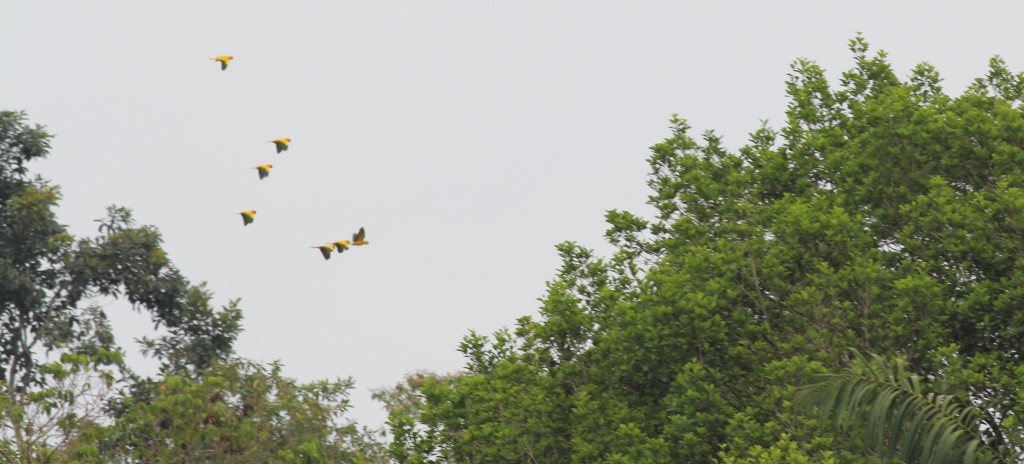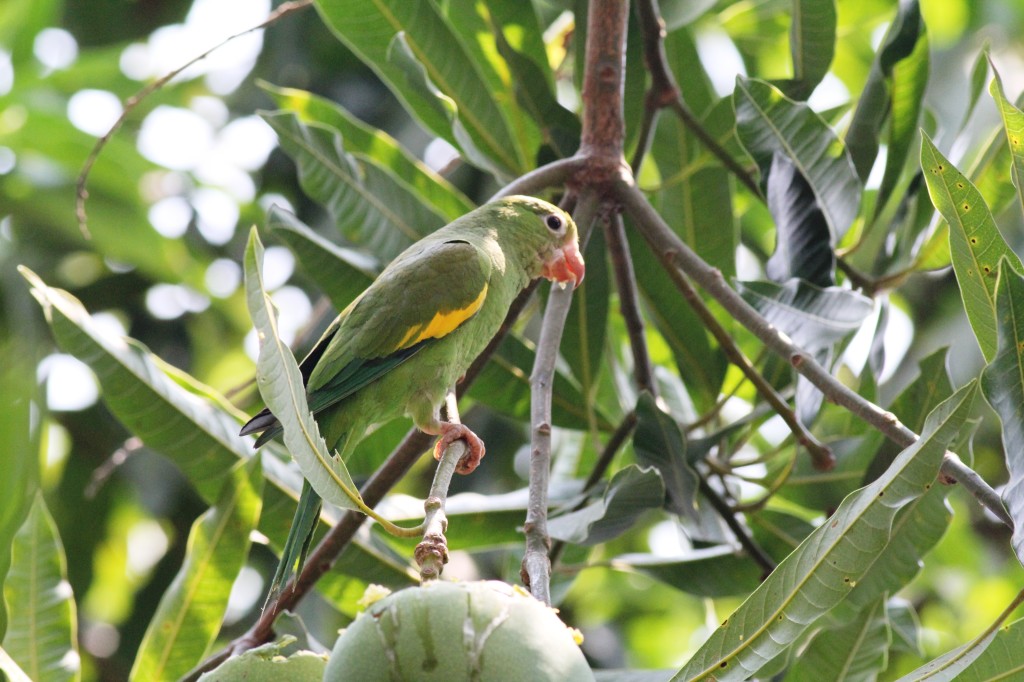I always advise bringing a birding field guide with you to help you identify the birds you see. Your guides will know the birds but especially in Brazil, they may not speak English……….but they can definitely point to the right photo in the book. This guide is very comprehensive and covers birds from the whole country. Some of the reviewers feel the book is a bit heavy to carry but most of them were happy with the quality of the guide. This is my affiliate link, I do appreciate your support if you use it to click through for any of your Amazon purchases.
Tag Archives: Brazilian Parrots
Golden Conure AKA Queen Of Bavaria Conure AKA Ararajuba (Guaruba guarouba)
This week, I would like to introduce you to my all-time favourite bird. In their native land, Brazil; they are known as Ararajuba. The Golden Parakeet or Golden Conure, (Guaruba guarouba), formerly classified as (Aratinga guarouba),is a species of Neotropical parrot. Sometimes known as the Queen of Bavaria Conure, it is the only species (monotypic) in the genus Guaruba.
Its plumage is mostly bright yellow, hence its common name, but it also possesses green remiges. It lives in the drier, upland rainforests in Amazonian Brazil, and is threatened by deforestation and flooding, and also by the now-illegal trapping of wild individuals for the pet trade. It is an endangered species listed on CITES appendix I.
Getting to see them in the wild is no easy feat! Their range is in a very remote area of Brazil and there are no eco-lodges or established eco-tourism in the area. The full story of my journey to see them can be seen in the April 2013 issue of Flock Talk by the World Parrot Trust. Scroll down and click on the PDF. The World Parrot Trust also has a species profile on this beautiful bird. At the end of this series, I will upload the text from this article written by myself with more photos and hyperlinks to all the posts I am doing to show you how to do this trip for yourself.
This is the range of Golden Conures as shown on Golden Conure Survival Fund. (For those who are curious, I did get a glimpse of a Hawkheaded Parrot at Cristalino).
Range of Golden Conures
The range of Golden Conures extends far westward into the Amazon basin reaching all the way to the right bank of the Madeira Rio in Amazonas state; the bird reaches as far east as the Gurupi in Maranhâo state. It is found in much higher density (almost ten times) within the confines of the current study area. This coincides almost directly with the heaviest deforestation zones (Hartley 8).
The Golden Conures are distributed in pockets strewn across northeastern Brazil, south of the Amazon River, in eastern Pará and northern Maranhâo to the western edge of Tapajós (Low 183). Their range has been reduced by as much as 30% in the last 2 to 3 decades.
In the map below, the red dots represent the airports (L-R: Manaus, Itaituba, Santarem, Belem) that are relevant to the journey. The yellow highlighted areas represent areas in which I found documented sightings of Golden Conures during my research. The highlighted area south of Itaituba is the Amazonia National Park where I ultimately got to see them. The yellow area between Santarem and Itaituba marked “CR” is roughly the location of the Cupari River in which the birds have been sighted by Gil Serique, a famous Brazilian guide. The yellow area marked “CX” is roughly the location of Caxiuanã National Forest. Finally, the other yellow area near the Tucurui Dam has had sightings of Golden Conures, though they may have been driven out by the deforestation in the area.
When I first started planning my trip, I had originally hoped to go to Caxiuana. At one point, they did have tourist accommodation but they stopped this several years ago. They still host groups of scientists, biologists and researchers. It seemed like it would be easy enough to get there from Belem and once there, there would be guides to help us find the birds. Directions to get there (in case they start accepting tourists again): The scientific station is located in the municipality of Melgaço, 350 km west of Belém, the capital city of the state of Pará. The trip to the scientific station has to be made in two stages. The first stage can be made by flying or traveling by commercial ship (12 hours) from Belém to the interior city of Breves along the south of the island of Marajó. For the second stage, one boards a motor launch in Breves run by the Goeldi Museum. The launch continues for 9 hours through the Melgaço Bay, located in the Rio Anapú basin, passes the villages of Melgaço and Portel, and up to Caxiuanã Bay. This last leg of the journey can also be made by speed boat, reducing the time of the journey to only 4 hours.
Gil Serique who lives in Alter do Chão – a beautiful beach town near Santarem can lead tourists to the Cupari River area and he knows a lot about these birds. My husband and I couldn’t afford to hire a charter boat and hire him for several days but anyone who has a group would be well advised to do so. There are no accommodations in this area so most people would be sleeping in hammocks either on the boat or ashore.
I finally chose Amazonia National Park since it was accessible by public transport and they have a bunkhouse at the Urua guard station. This is the trip I will be blogging about in hopes that others who care about these birds can see them before it’s too late.
Although I managed to get some photos of the wild Golden Conures, I didn’t have time to get video as it all happened so fast. Luckily there is a professional clip on YouTube (Portuguese language) with some amazing footage of these stunning birds. You also get a glimpse of my guide, Gilberto da Silva. Even as I watch this 8 months after my trip, my heart still skips a beat as I remember my brief but unforgettable encounter with the Ararajubas of Brazil!
Yellow-Chevroned Parakeet (Brotogeris chiriri)
The Yellow-chevroned Parakeet (Brotogeris chiriri) is native to tropical South America south of the Amazon River basin from central Brazil to southern Bolivia, Paraguay and northern Argentina.
This map shows their range. They are very easily found in the Pantanal. The photo above was taken in the grounds of Pousada Piuval last September. Yellow-chevroned Parakeets usually find holes in trees to nest in. They will also form nesting tunnels in dead palm fronds. It lays 4-5 eggs. After raising its young, all birds will form rather large communal roosts until the next breeding season.
Yellow-Chevroned Parakeet Range
This video shows what a pleasant chirp they have!
List Of Parrots In Brazil
Hyacinth Macaw – Anodorhynchus hyacinthinus
Lear’s Macaw – Anodorhynchus leari
Spix’s Macaw – Cyanopsitta spixii (extinct in the wild but being re-established)
Blue-and-yellow Macaw – Ara ararauna
Scarlet Macaw – Ara Macao
Red-and-green Macaw – Ara chloroptera
Chestnut-fronted Macaw – Ara severa
Red-bellied Macaw – Orthopsittaca manilata
Blue-headed Macaw – Primolius couloni
Blue-winged Macaw – Primolius maracana Vulnerable
Golden-collared Macaw – Primolius auricollis
Red-shouldered Macaw – Diopsittaca nobilis
Golden Parakeet – Guarouba guarouba
Blue-crowned Parakeet – Aratinga acuticaudata
White-eyed Parakeet – Aratinga leucophthalmus
Sulphur-breasted Parakeet – Aratinga maculata
Sun Parakeet – Aratinga solstitialis
Jandaya Parakeet – Aratinga jandaya
Golden-capped Parakeet – Aratinga auricapilla
Dusky-headed Parakeet – Aratinga weddellii
Brown-throated Parakeet – Aratinga pertinax
Peach-fronted Parakeet – Aratinga aurea
Caatinga Parakeet – Aratinga cactorum
Nanday Parakeet – Nandayus nenday
Blue-throated Parakeet – Pyrrhura cruentata
Blaze-winged Parakeet – Pyrrhura devillei
Maroon-bellied Parakeet – Pyrrhura frontalis
Crimson-bellied Parakeet – Pyrrhura perlata
Pearly Parakeet – Pyrrhura lepida
Green-cheeked Parakeet – Pyrrhura molinae
Painted Parakeet – Pyrrhura picta
Rose-fronted Parakeet or Red-crowned Parakeet – Pyrrhura roseifrons
Deville’s Parakeet – Pyrrhura lucianii
Hellmayr’s Parakeet – Pyrrhura amazonum
Madeira Parakeet – Pyrrhura snethlage
Fiery-shouldered Parakeet – Pyrrhura egregia
White-eared Parakeet – Pyrrhura leucotis
Maroon-tailed Parakeet – Pyrrhura melanura
Black-capped Parakeet – Pyrrhura rupicola
Monk Parakeet – Myiopsitta monachus
Green-rumped Parrotlet – Forpus passerinus
Blue-winged Parrotlet – Forpus xanthopterygius
Dusky-billed Parrotlet – Forpus sclateri
Plain Parakeet – Brotogeris tirica
White-winged Parakeet – Brotogeris versicolurus
Yellow-chevroned Parakeet – Brotogeris chiriri
Cobalt-winged Parakeet – Brotogeris cyanoptera
Tui Parakeet – Brotogeris sanctithomae
Golden-winged Parakeet – Brotogeris chrysopterus
Tepui Parrotlet – Nannopsittaca panychlora
Amazonian Parrotlet – Nannopsittaca dachilleae
Lilac-tailed Parrotlet – Touit batavica
Scarlet-shouldered Parrotlet – Touit huetii
Sapphire-rumped Parrotlet – Touit purpurata
Brown-backed Parrotlet – Touit melanonota
Golden-tailed Parrotlet – Touit surda
Black-headed Parrot – Pionites melanocephala
White-bellied Parrot – Pionites leucogaster
Vulturine Parrot – Pionopsitta vulturina
Bald Parrot – Pionopsitta aurantiocephala
Orange-cheeked Parrot – Pionopsitta barrabandi
Caica Parrot – Pionopsitta caica
Pileated Parrot – Pionopsitta pileata
Short-tailed Parrot – Graydidascalus brachyurus
Blue-headed Parrot – Pionus menstruus
Scaly-headed Parrot – Pionus maximiliani
Dusky Parrot – Pionus fuscus
Red-spectacled Amazon – Amazona pretrei
Red-lored Amazon – Amazona autumnalis
Blue-cheeked Amazon – Amazona dufresniana
Red-browed Amazon – Amazona rhodocorytha
Red-tailed Amazon – Amazona brasiliensis
Festive Amazon – Amazona festiva
Blue-fronted Amazon – Amazona aestiva
Yellow-crowned Amazon – Amazona ochrocephala
Kawall’s Amazon – Amazona kawalli
Orange-winged Amazon – Amazona amazonica
Mealy Amazon – Amazona farinosa
Vinaceous Amazon – Amazona vinacea
Yellow-faced Parrot – Alipiopsitta xanthops
Red-fan Parrot – Deroptyus accipitrinus
Blue-bellied Parrot – Triclaria malachitacea




